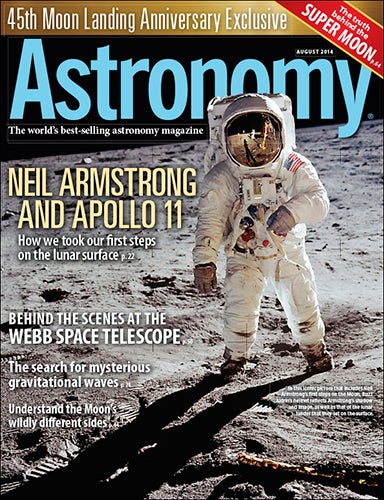
Astronomy offers you the most exciting, visually stunning, thorough, and timely coverage of the heavens above. Each monthly issue includes expert science reporting, vivid color photography, complete sky-event coverage, spot-on observing tips, informative equipment reviews, and more. All of this comes in an easy-to-understand user-friendly style that’s perfect for astronomers at any level. Contact Astronomy, the world’s best-selling astronomy magazine, at 262.796.8776 or email editor@astronomy.com.
Waukesha, Wis. – A billion people watched Neil Armstrong step onto the lunar surface in 1969 and heard him utter the instantly famous line “That’s one small step for man, one giant leap for mankind.” To celebrate the 45th anniversary of that event, Astronomy magazine’s cover story gives the inside story of the first steps on the Moon. Space reporter Jay Barbree, who covered all of the Apollo missions, describes the moonwalk in detailed prose in “How one small step became a giant leap,” which is an excerpt from his new book, Neil Armstrong: A Life of Flight (St. Martin’s Press, 2014).
In his story, Barbree describes the thoughts and feelings that both Armstrong and fellow astronaut Buzz Aldrin had while exploring our planet’s satellite. He expresses the “magnificent desolation” of the lunar scene: “A sky that was the darkest of black. No blue. No birds. No green below. There were many shades of gray on the surface and areas of utter black where rocks cast their shadows from an unfiltered Sun, but no real color.”
While the first steps on the lunar surface 45 years ago were inspirational and a source of national pride, they also helped make great strides in scientists’ understanding of the Moon’s composition and evolution. Read more about the first moonwalk in the August 2014 issue of Astronomy magazine, on newsstands July 1.
“Probing the cosmos with gravitational waves”
Light and other types of electromagnetic radiation are the carriers of almost all the information we have obtained about the universe. But gravitational radiation also transports energy as waves. These ripples in space-time can tell astronomers about the most violent events in the cosmos, like exploding stars and colliding black holes. Observatories are looking for the ripples, and projects coming online in the next few years should be able to make the first definitive detection of gravitational waves. Science journalist Bruce Dorminey describes the search for these elusive waves in “Probing the cosmos with gravitational waves.”
“Faceoff! The Moon’s oddly different sides”
The nearside and farside of the Moon don’t look like they belong to the same object. Clues unearthed by two NASA lunar observatories suggest the two halves formed differently – although researchers don’t know exactly how. Science journalist Jesse Emspak describes the new observations, what they tell scientists about Earth’s only natural satellite, and the three leading formation scenarios in “Faceoff! The Moon’s oddly different sides.”
“The truth behind the Super Moon”
The year’s closest Full Moon arrives August 10, and contrary to popular belief, it will not blind us, explode, or bring about the apocalypse. Senior Editor Michael E. Bakich helps you separate reality from rumor and shows you how to use this event as an outreach opportunity in “The truth behind the Super Moon.”
August night-sky events visible without optical aid
- August 10 – The closest Full Moon of 2014 occurs.
- August 13 – The Perseid meteor shower peaks.
- August 18 – The two brightest planets, Venus and Jupiter, appear just 0.2° apart before dawn.
- August 24 – The Moon passes 6° south of Venus.
- August 27 – Mars and Saturn appear 4° apart an hour after sunset in the southwestern sky.
Also in the August 2014 Astronomy
- “The James Webb Space Telescope takes shape” – In January, journalist Nola Taylor Redd toured the Goddard Space Flight Center for an exclusive look at the nuts and bolts of the world’s largest space telescope.
- “Wander fall’s deep sky” – Whatever size telescope you own, set it up this season and hunt down these impressive sights.
- “How Astro Tanja captures the southern sky” – In just two years, this skywatcher taught herself astroimaging. The results speak for themselves.
- “Road test: MallinCam Jr Pro” – Set up your scope, a monitor, and this video camera, and you’ll be a hit at star parties.
- “The Sky this Month” – Exclusive star charts will guide you through August’s night sky.
- The August issue of Astronomy also includes Astro News, Ask Astro, Snapshot, Breakthrough, Bob Berman’s Strange Universe, Glenn Chaple’s Observing Basics, Stephen James O’Meara’s Secret Sky, Adam Block’s Cosmic Imaging, New Products, Letters, Web Talk, Cosmic World, Reader Gallery, and Final Frontier.









